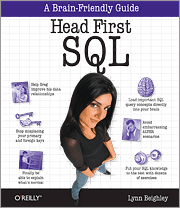Head First SQL is specifically aimed at people who currently know little or nothing about SQL (Structured Query Language), database theory and schema design. It makes no assumptions about the reader having any experience of databases under the hood; it is very much a beginner’s first book. If you already write SQL as part of your job then I’d be surprised (and possibly worried!) if you will learn anything new.
All the SQL topics discussed are database vendor agnostic and therefore transferable between different database systems. It covers all the standard things you would expect to find: selects, inserts, updates, deletes, joins, where-filters, grouping, ordering etc.
From a personal perspective, I would have dearly liked the book to start at Chapter 11, “The Top Ten Topics (we didn’t cover)”. One topic that is given just 3 short paragraphs is ‘Indexing’. Given that this is a beginners book (and not database specific) you might think that the topic should be left for more advanced books, and I agree to an extent. Admittedly, indexing is an implementation detail and does not have anything to do with a domain model, but it is so often overlooked or misunderstood by developers. I think at least a high level knowledge of indexes and retrieval mechanisms would be beneficial.
Disclosure: The Perth .NET User Group is a member of the O’Reilly User Group and Professional Association Program. O’Reilly make copies of their books available for user group libraries, and the copy reviewed here was kindly donated by O’Reilly.



